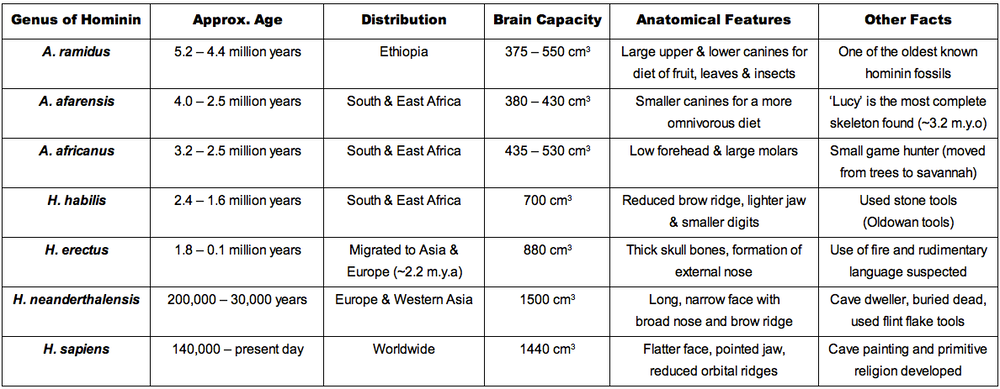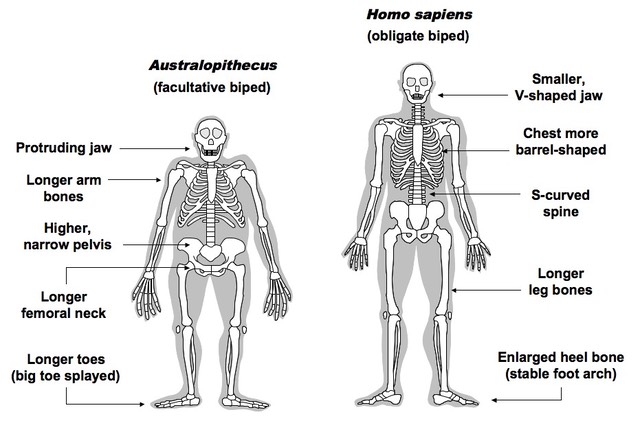D.3.1 Outline the method for dating rocks and fossils using radioisotopes, with reference to 14C and 40K
Radiocarbon Dating
- All living things are built from carbon-based organic matter
- While alive, this carbon content exists as a mixture of two isotopes - 12C (stable) and 14C (radioactive) - maintained in constant proportions
- When an organism dies, the proportion of radioactive 14C begins to decrease as it is no longer being replaced from the environment
- The proportion of 14C remaining can be used to identify the age of a sample
- Carbon-14 analysis is only an effective means of dating for sample up to ~60,000 years of age as it has a half life of only 5,730 years
Potassium-Argon Dating
- Longer range dating can be accomplished by dating the rocks around a fossil to determine an age range (i.e. relative dating)
- These dating techniques can only be undertaken on igneous rocks, not on the fossils themselves or the sedimentary rock in which they are found
- 40K is released in lava from active volcanos and decays into 40Ar with a half life of 1,300 million years
- Using the time of the volcanic eruption as a zero time point, the age of the strata in which the fossil was found can be determined
- As any 40Ar would have been released during the eruption as a gas, levels of 40Ar in the strata provide an indication of relative age
D.3.2 Define half-life
The half life of a radioisotope is a measure of the time taken for the radioactivity to fall to half its original level
- In other words, it is a measure of the time taken for half the atoms in a radioactive sample to decay
D.3.3 Deduce the approximate age of materials based on a simple decay curve for a radioisotope

D.3.4 Describe the major anatomical features that define humans as primates
Primates are adapted for an arboreal (tree-dwelling) life in a forest environment and possess the following features:
- Forward facing eyes (binocular vision)
- Larger brains (improved cognition)
- Opposable thumbs (capable of power grip and precision grip)
- Finger pads with nails instead of claws (improved tactile sensitivity)
- Skull adapted for upright posture (downward facing foramen magnum)
- Rotating hand / forelimb (capable of pronation)
- Flexible shoulder joints (shoulder blades on dorsal side of the thorax)
D.3.5 Outline the trends illustrated by the fossils of Ardipithecus radius, Australopithecus including A. afarensis and A. africanus, and Homo including H. habilis, H. erectus, H. neanderthalensis and H. sapiens

Evolutionary Trends
By comparing the different types of hominin fossils, we can identify key evolutionary trends:
- More downward facing foramen magnum (caused by a transition to bipedalism)
- S-shaped curvature of the spine (an artifact of an increasingly erect posture)
- Lower and broader pelvis (bipedalism has changed the hominin birthing patterns and behaviours)
- Change in relative lengths of arm and leg bones (arms have become relatively shorter and legs longer due to walking upright)
- Increased size of heel bone and alignment of big toe (changes in feet to become greater weight-bearing structures)
- Flatter faces, with reduced brow ridges and jaw protrusion (head is no longer the most anterior part of the body)
- Larger cranial capacity with increased brain size and greater encephalisation (greater intellectual prowess)
- Smaller teeth and jaws more V-shaped (reflecting changing dietary requirements with less emphasis on tough vegetation)
- Marked reduction in body hair (improved hunting and cultural practices have lead to the development of warm clothing)
- Shift in muscle groups (particularly the gluteal and hamstring groups, in order to accommodate new mode of locomotion)
Comparison of Early and Recent Hominin Skeletons

D.3.6 State that, at various stages in hominid evolution, several species may have coexisted
Several species of hominid may have co-existed at the same time:
- Homo habilis may have co-existed with various species of Australopithicus
- Homo neanderthalensis likely co-existed with Homo sapiens
D.3.7 Discuss the incompleteness of the fossil record and the resulting uncertainties about human evolution
Incompleteness of the Fossil Record
- Fossilisation is an exceptionally rare occurrence that requires an unusual combination of special conditions
- Most living things tend to decompose rapidly (or be scavenged) following death
- Fossilisation tends to favour hard body parts (bone, teeth, shells, etc.) and exposed fossils will soon be weathered / destroyed
- Only a small percentage of fossils have been discovered - fossilisation favours species that were long-lived and widespread
Significance of Incompleteness of the Fossil Record
- Individual fossils may not be representative of species (e.g. Homo floresiensis - 'Hobbit' man)
- Very few complete skeletons have been discovered, and so paleoanthropology is an inductive (data-poor) science
- Many conclusions have been drawn on limited data and are frequently re-interpreted in the light of new discoveries
D.3.8 Discuss the correlation between the change in diet and increase in brain size during hominid evolution
- A change in habitat in Africa ~2.5 million years ago may have prompted the emergence of Homo species from forest to savannah
- This necessitated a change of diet to include meat (more protein), which increased the skull capacity and brain size of hominids
- Improved diet quality provided energy to support greater brain function and learning capacity (positive correlation)
- Activities resulting from improved cognition (such as group hunting and cooking food) enabled hominids to eat a wider variety of food
Hominid Skull Development

D.3.9 Distinguish between genetic and cultural evolution
Genetic evolution involves physical changes in the human genome which become inherited (passed on through reproduction)
- It involves the transfer of genes from one generation to the next (slow transfer)
Cultural evolution involves changes in human thinking and can be passed on by communication / social interaction
- It involves the transfer of ideas / information either within or across many generations (fast transfer)
D.3.10 Discuss the relative importance of genetic and cultural evolution in the recent evolution of humans
- Changes in genotype (genetic evolution via natural selection) have lead to cultural evolution in humans by promoting intelligent behaviour
- Larger brain sizes have promoted increased learning capacity / greater cognitive ability
- Prolonged gestations have promoted social interaction / familiy networks
- Bipedalism has promoted extensive migration and improved socialisation tendencies
- Shorter finger bones and reduced reliance on forelimbs for locomation have promoted increased tool manipulation
- Evolution of culture (e.g. art, science, language) has been more rapid and recent than genetic evolution (which requires many generations)
- Further cultural evolution (through genetic engineering) may hasten changes in our genetic evolution
- Certain products of cultural evolution (e.g. medicines) may reduce genetic evolution via natural selection
- Other products of cultural evolution (e.g. pollution) may increase genetic evolution (increased mutagenic rate)